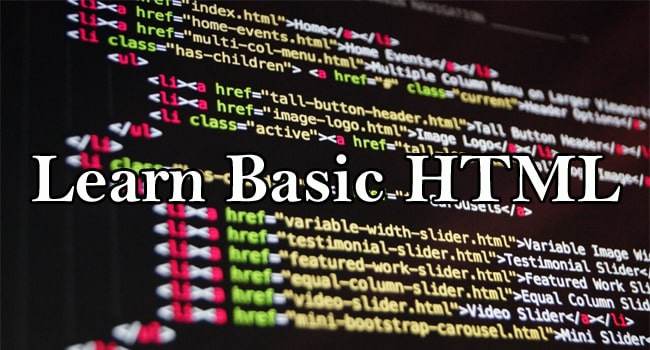Learn Basic HTML
In this course in Basic HTML in Urdu Hindi Free Tutorial students will get to know basic HTML. And create a basic website.
HTML stands for Hypertext Markup Language. It is a set of symbols or the codes that are inserted in a file intended for being displayed on a World Wide Web browser page. These codes are supposed to tell the Web browser how a Web page’s words or images are to be displayed.
Each markup code is referred to as an ‘element’ (commonly referred to as a ‘tag’). Some of these elements are used in the form of pairs. For the reason, that they can identify the starting and ending of the supposed display effect. An example would be:
HTML Basic Code For Create a New Page
<html>
<head>
<title>Basic HTML in Urdu Hindi</title>
<meta name=”description” content=”In this course in Basic HTML in Urdu Hindi Free Tutorial students will get to know basic HTML.“>
<meta name=”keywords” content=”Basic HTML in Urdu Hindi“>
</head>
<body>
</body>
</html>
- The <!DOCTYPE html>declaration defines this document to be HTML5
- The text between <html>and </html> describes an HTML document
- The text between <head>and </head> provides information about the document
- The text between <title>and </title> provides a title for the document
- The text between <body>and </body> describes the visible page content
- The text between <h1>and </h1> describes a heading
- The text between <p>and </p> describes a paragraph
Using this description, a Web browser would display a document with a heading and a paragraph.
Web browsers such as Google Chrome or Mozilla Firefox, would not show the actual HTML tags, but rather use them to display your Web page.
HTML Versions:
Among the many versions of HTML, these are the recent ones:
- HTML 4.01 (year 1999)
- XHTML (year 2000)
- HTML5 (year 2014)
HTML Documents:
HTML documents start with a document type declaration such as:
- <!DOCTYPE html>
Then the HTML document itself begins with <html> and ends with </html>.
The HTML document that is actually visible is between <body> and </body>.
HTML Links:
HTML links are defined with the <a> tag. Example:
- <ahref=”http://www.w3schools.com”>This is a link</a>
The href attribute specifies the link’s destination. Attributes are used to define additional information about HTML elements.
HTML Elements:
HTML elements consist of a start tag and end tag, with the content in between.
HTML Tag Reference:
The tag <p> defines a paragraph, <br> inserts a single line break and <pre> defines a pre-formatted text.
HTML Quotation and Citation Elements:
The tag <abbr> defines and abbreviation or acronym, <address> defines contact information for the author of a document, <bdo> defines the text direction, <blockquote> defines a section that is quoted from another source, <cite> defines the title of a work, and <q> defines a short inline quotation.
HTML Computer Code Elements:
The tag <code> defines programming code, <kbd> defines keyboard input, <samp> defines computer output, <var> defines a variable, and <pre> defines pre-formatted text.
HTML Image Tags:
The tag <img> defines an image, the <map> defines an image-map, and the <area> defines a clickable area inside an image-map.
HTML List Tags:
The tag <ul> defines an unordered list, <ol> defines an ordered list, <li> defines a list item, <dl> defines a description list, <dt> defines the term in a description list, and <dd> defines the description in a description list.
HTML Grouping Tags:
The tag <div> defines a section in a document (block-level) and <span> defines a section in a document (inline).
